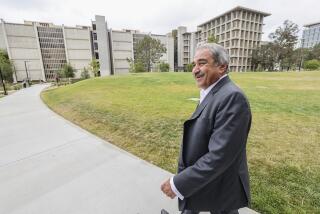Bus Ride on the Information Superhighway
- Share via
Staff and students at UC San Diego don’t have to wait until they get home to check their e-mail or get the latest news updates.
The “CyberShuttle” takes commuters from campus to a popular commuter rail station--all the while offering high-speed, wireless Internet access.
The shuttle bus is a result of a partnership between UC San Diego and wireless technology firm Qualcomm Inc. Together they have developed a faster mobile wireless service that allows people to use their laptops, cell phones or hand-held computers to log on to the Internet during what would otherwise be down time.
“People can connect from the bus to the rest of the world,” said Elazar Harel, UC San Diego assistant vice chancellor for administrative computing and telecommunications. “It’s a very exciting thing for us.”
Roberto Padovani, chief technology officer at Qualcomm, describes the mobile access as a marriage of two technologies. The bus is equipped with two boxes. One connects to the campus wireless network while the other, called an HDR modem, uses cell phone towers to provide continuous connectivity to the Internet.
Both devices are powered by the vehicle’s battery. The only requirement for users is that they have a wireless network card. The cards cost about $100, but many people on campus already use them to connect to UC San Diego’s network, Harel said.
Mobile Internet access is not new, at least for those with text-message pagers and cell phones. The difference on the UC San Diego bus is in the speed and range of the technology, Padovani said.
Current technology moves information at about 20 kilobits per second, while the new technology’s peak rate is more than 200 kilobits per second.
It’s faster than a cable modem, Harel says, and would have the same feel as connecting a stationary computer via a digital subscriber line, or DSL.
“The joke that we tell is that the bus is moving at 55 mph on the freeway but at 2 million bits per second on the information superhighway,” Harel said.
The technology enables 50 to 100 commuters to be online at once, and the range is a radius of about 10 miles.
So far, the technology has been installed on a single shuttle, which runs around campus and to the Sorrento Valley train station, about 10 miles away.
Several commuters found out about the service by accident, before it was announced early last week.
“People were on the bus, turned on their laptop and saw that they had [Internet] access,” Harel said. “They were very happy.”
Early feedback has been so positive, says Ramesh Rao, director of the San Diego division of Cal-IT2, a partnership between UC San Diego, UC Irvine and the private sector, that the school hopes to outfit every campus shuttle.
The San Diego campus may even expand use of the technology in the fall by handing out the lunchbox-size wireless modems to a few incoming freshmen. Those students, and anyone nearby, would then be able to make speedy connections to the Internet from their dorm rooms, the quad or the cafeteria.
Rao already has his own wireless modem, which he says he usually keeps at home but would gladly tote around.
“I can throw it in my car,” Rao said. “Sometimes you go on long drives--I would love to stay connected.”
Giving the boxes to students, who would pay nothing for the service, will give researchers new insight into possible uses.
Qualcomm has licensed the high-speed technology to providers such as Verizon, which is conducting a trial of the technology in Washington, D.C. The service also will be tested in the city of San Diego this June.
To prepare for the trials, cellular towers will be outfitted with technology equivalent to Rao’s black box.
Users would need only to install a special network card on their laptops, said Daniel Jaurigue, Southern California executive director of network for Verizon.
He describes the cards as the size of a pen cap. The technology should be available commercially in about a year, Jaurigue said.






